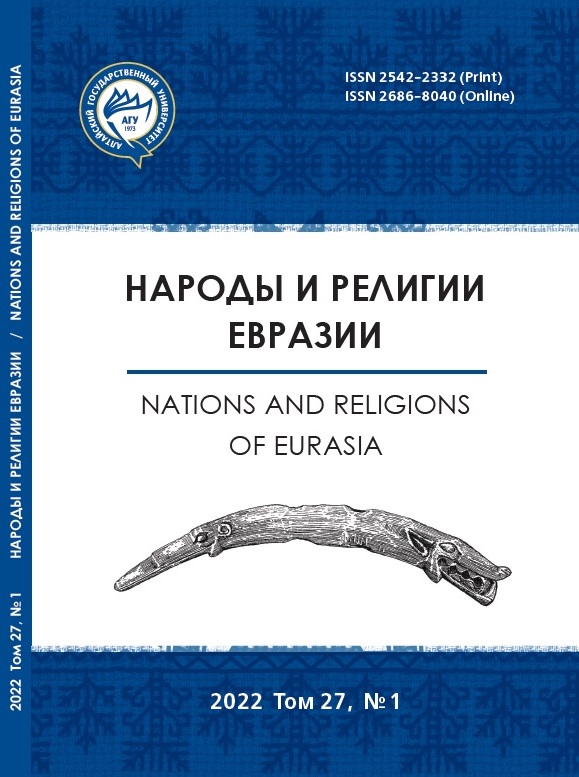Ancient orthodoxy in the imperial discourse of the russian statehood
Main Article Content
Abstract
Abtract. The article gives a comparative analysis of the integration capabilities of both branches of Russian Orthodoxy: both its ancient Russian national version and the universal version formed during the church reform of Patriarch Nikon and Tsar Alexei Mikhailovich. The relevance of the topic is due to the presence of historical parallels between modernity and the realities of the XVII century. In particular, the problem of reintegration of one or another part of the post-Soviet space is largely correlated with the implementation of the imperial ambitions of Moscow Russia. In this aspect, the ideological basis of this process is of great importance. At the present stage, as in the historical past, Orthodoxy can play this role as a fundamental component of Russian civilization.
Historical experience shows that for the implementation of integration aspirations it is equally important to be able to offer projects that are attractive to all parties involved in this process, leaving room for their cultural identity, in whatever form it appears, while ensuring the development of strong spiritual supra-ethnic, binding began. In this situation, it is possible to use the experience of the Russian people in creating an imperial space, the central driving force of which was the promotion of Orthodox Christianity in its various versions, in order to adapt heterogeneous identities, meanings and ideologies. If universal Orthodoxy visibly played its integrating role on the western frontiers of the Russian Empire, in relation to fraternal East Slavic Christianized peoples, then its ancient Russian national version showed its hidden imperial essence in the eastern territories, uniting ethnic groups around themselves with a more sacral consciousness. In this process, the key assimilative property of the Old Believers was the archaic nature of their religiosity, which brings it closer to a pre-Christian worldview.
Article Details
How to Cite
References
Асочакова В. Н. Социально-политические аспекты христианизации коренных народов Сибири // Вестник Хакасского гос. ун-та им. Н. Ф. Катанова. Серия: История и археология. Абакан, 2015. С. 24-26.
Гакстгаузен А. Исследование внутренних отношений народной жизни и в особенности сельских учреждений России. М., 1870. 490 с.
Гиляров-Платонов Н. П. Логика раскола. Письма И. С. Аксакову // Н. П. Гиляров-Платонов : сборник сочинений : в 2 т. М., 1899. Т. 2. С. 193-235.
Громогласов И. М. Русский раскол и вселенское православие: публичная лекция. Сергиев Посад, 1898. 44 с.
Диспут о старообрядчестве // Церковь. 1914. № 17. С. 412-414.
Зеньковский С. А. Раскол и судьбы империи // Русское старообрядчество : в 2 т. / сост. Г. М. Прохоров ; общ. ред. В. В. Нехотина. М., 2009. Т. 2. С. 627-639.
Кириллов И. А. Национализм старообрядчества // Слово Церкви. 1914. № 4. С. 98100; № 5. С. 129-132.
Лилеев М. И. Из истории раскола на Ветке и Стародубье. XVII-XVIII вв. Киев, 1895. Вып. 1. 614 с.
Никольский Н. М. История русской церкви / науч. ред. Н. С. Гордиенко. 3-е изд. М., 1983. 448 с.
Поташенко Г. В. Староверие в Литве. Вторая половина XVII - начало XIX в. Исследования, документы и материалы. Вильнюс, 2006. 544 с.
Рейснер М. А. Мораль, право и религия по действующему русскому закону. (Юридико-догматические очерки). Очерк II: Веротерпимость и национальный принцип по действующему праву // Вестник Права. Журнал Юридического общества при Императорском Санкт-Петербургском университете. 1900. № 4 и 5. С. 1-49.
Фишман О. М. Жизнь по вере: тихвинские карелы-старообрядцы. М., 2003. 408 с.
Хренчук Д. Община русских липован в Буковине: этническое и религиозное тождество // Старообрядцы в зарубежье. История. Религия. Культура. Торунь: Instytutu Filologii Słowiańskiej UMK, 2008. С. 27–29.
Чувьюров А. А. Таинство крещения коми старообрядцев-беспоповцев // Старообрядчество: история, культура, современность. М. : Музей истории и культуры старообрядчества, 2005. № 9. С. 30-37.
Шалаев [Мельников Ф. Е.]. Церковная жизнь и революция // Сибирский старообрядец. 1919. № 6. С. 2-4.
Штайнке К. Старообрядцы в Болгарии // Традиционная духовная и материальная культура русских старообрядческих поселений в странах Европы, Азии и Америки : сб. науч. тр. / отв. ред. Н. Н. Покровский, Р. Моррис. Новосибирск : Наука, 1992. С. 253-257.
Ядринцев Н. М. Сибирские инородцы, их быт и современное положение: этнографические и статистические исследования с приложением статистических таблиц. СПб., 1891. 308 с.
Snarski K. The Russian Old believer community in the civil records of the Suvalki region. 1849-1886 // Старообрядцы в зарубежье. История. Религия. Культура. Торунь : Instytutu Filologii Slowianskiej UMK, 2008. С. 75-77.

